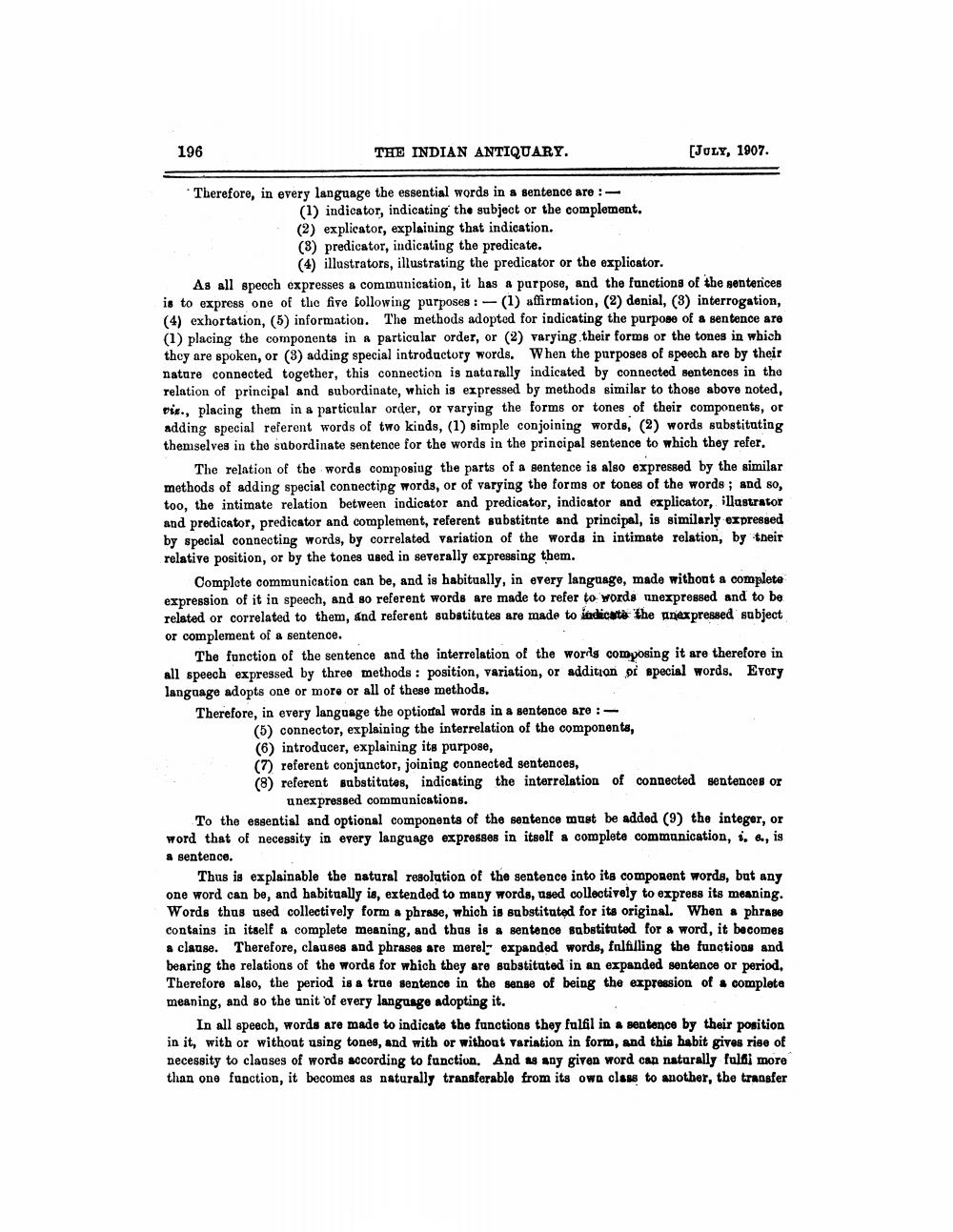________________
196
THE INDIAN ANTIQUARY.
[JULY, 1907.
Therefore, in every language the essential words in a sentence are :
(1) indicator, indicating the subject or the complement.
(2) explicator, explaining that indication.
(8) predicator, indicating the predicate.
(4) illustrators, illustrating the predicator or the explicator.
As all speech expresses a communication, it has a purpose, and the functions of the sentences is to express one of the five following purposes: (1) affirmation, (2) denial, (3) interrogation, (4) exhortation, (5) information. The methods adopted for indicating the purpose of a sentence are (1) placing the components in a particular order, or (2) varying their forms or the tones in which they are spoken, or (3) adding special introductory words. When the purposes of speech are by their nature connected together, this connection is naturally indicated by connected sentences in the relation of principal and subordinate, which is expressed by methods similar to those above noted, viz., placing them in a particular order, or varying the forms or tones of their components, or adding special referent words of two kinds, (1) simple conjoining words, (2) words substituting themselves in the subordinate sentence for the words in the principal sentence to which they refer.
The relation of the words composing the parts of a sentence is also expressed by the similar methods of adding special connecting words, or of varying the forms or tones of the words; and so, too, the intimate relation between indicator and predicator, indicator and explicator, illustrator and predicator, predicator and complement, referent substitute and principal, is similarly expressed by special connecting words, by correlated variation of the words in intimate relation, by their relative position, or by the tones used in severally expressing them.
Complete communication can be, and is habitually, in every language, made without a complete expression of it in speech, and so referent words are made to refer to words unexpressed and to be related or correlated to them, and referent substitutes are made to indicate the unexpressed subject or complement of a sentence.
The function of the sentence and the interrelation of the words composing it are therefore in all speech expressed by three methods: position, variation, or addition or special words. Every language adopts one or more or all of these methods.
Therefore, in every language the optional words in a sentence are:
(5) connector, explaining the interrelation of the components,
(6) introducer, explaining its purpose,
(7) referent conjunctor, joining connected sentences,
(8) referent substitutes, indicating the interrelation of connected sentences or unexpressed communications.
To the essential and optional components of the sentence must be added (9) the integer, or word that of necessity in every language expresses in itself a complete communication, i, e., is
a sentence.
Thus is explainable the natural resolution of the sentence into its component words, but any one word can be, and habitually is, extended to many words, used collectively to express its meaning. Words thus used collectively form a phrase, which is substituted for its original. When a phrase contains in itself a complete meaning, and thus is a sentence substituted for a word, it becomes a clause. Therefore, clauses and phrases are merely expanded words, fulfilling the functions and bearing the relations of the words for which they are substituted in an expanded sentence or period, Therefore also, the period is a true sentence in the sense of being the expression of a complete meaning, and so the unit of every language adopting it.
In all speech, words are made to indicate the functions they fulfil in a sentence by their position in it, with or without using tones, and with or without variation in form, and this habit gives rise of necessity to clauses of words according to function. And as any given word can naturally fulfii more than one function, it becomes as naturally transferable from its own class to another, the transfer




